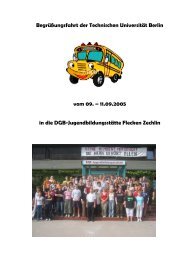Elegantes Telefax - JAV der TUB - TU Berlin
Elegantes Telefax - JAV der TUB - TU Berlin
Elegantes Telefax - JAV der TUB - TU Berlin
You also want an ePaper? Increase the reach of your titles
YUMPU automatically turns print PDFs into web optimized ePapers that Google loves.
31<br />
cation and explanation of the Bank with the recommendations of the World Commission<br />
of Dams (WCD 2001). Here agreement with the core values and the seven strategic<br />
priorities is clarified, but also the differences between three of the 26 guidelines<br />
emphasized. The first important is the guidance on “prior informed consent” of affected<br />
and indigenous people which would amount in the view of the authors in a virtual<br />
veto right. The second concerns the continued “proactive engagement” of the<br />
World Bank in countries that are not “not already negotiating with their neighbors on<br />
international waters” (World Bank 2004, 38) instead of the recommended disengagement.<br />
The third is the WCD’s suggested “multi-stage, negotiated approach to<br />
project preparation” which is consi<strong>der</strong>ed impractical and the equivalent to the preclusion<br />
of dam construction (World Bank 2004, 38).<br />
The World Bank’s role is described as having comparative advantages in its combination<br />
of knowledge, financial resources and engagements in all water sub-sectors<br />
and scale and its ability to integrate them. For middle income countries, the Bank’s<br />
financing is less preferred, compared to all other sources because of the complexity<br />
of the procedures of the Bank, the resulting high transaction costs and the risk aversion<br />
of the Bank.<br />
The identified strategic options deal with the improved adoption of the IWRM approach,<br />
the role of the Bank in attracting additional sources of financing for water resource<br />
infrastructure and the decision-making about re-entering hydraulic infrastructure<br />
(the business model dealing with high risk). The engagement in water resources<br />
management is seen as an objective with a broad consensus; the major problem is<br />
the identification of opportunity, the sequencing of steps in widely varying country<br />
circumstances. Here the major answer is the improvement of country analytic work,<br />
by including the political economy of reform and the integration of the Country Water<br />
Resource Assistance Strategy in the overall country strategy. The financing section<br />
analyses the development of private investment in the water infrastructure, particularly<br />
the shortcomings for small countries and the resulting collaborative publicprivate<br />
partnership approach in which the Bank can play a major knowledge-based<br />
role. The final discussion of the more effective business model deals generally with<br />
the approach to risky decisions and the implication of risk aversion on the Bank’s<br />
side for low and middle income borrowing countries, i.e. the interest of these countries<br />
in having a less risk averse approach of the Bank to complex water infrastructure.<br />
Then, the implications for the management of these projects are debated with a<br />
proposal of treating them as corporate projects with responsibility on a higher management<br />
level, i.e. country directors and regional vice presidents, being able to<br />
command the Bank’s internal resources to improve the implementation of environrisk<br />
hydraulic infrastructure.





